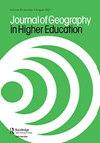GIS学习与大学生空间概念的获取与理解
IF 1.8
4区 教育学
Q2 EDUCATION & EDUCATIONAL RESEARCH
引用次数: 0
摘要
地理信息系统学习在培养学生对各种空间概念的理解中所起的具体作用,目前还缺乏实证证据。本研究旨在引起人们对地理空间概念学习中常见问题的关注,并为未来GIS学习和学生空间概念词汇的发展提供方向。Glessmer和Brose(2014)提出的三种类型的技术术语——中性的、有用的联想和阻碍联想——提供了一个很好的框架来解释为什么有些概念或多或少对学生来说很难掌握。我们的研究结果表明,学习地图比例尺和地图投影相对容易,因为它们是中性的,并且是作为新词汇引入的。叠加(Overlay)和密度(density)这两个词能激发有用的联想,因为它们在日常语言中具有相似的含义,所以大多数学生理解这些概念的含义没有问题。空间联想似乎引发了无益的联想,因为日常使用的“联想”一词不足以精确地定义空间联想,导致学生与其他术语混淆。未来的研究必须在地理信息系统的背景下进行,要求学生不仅能够了解空间概念,而且能够清楚地表达有关各种地理信息系统应用的这些概念。关键词:空间概念误解gis学习gis教育空间思维披露声明作者未报告潜在的利益冲突。本文章由计算机程序翻译,如有差异,请以英文原文为准。
GIS learning and college students’ acquisition and understanding of spatial concepts
ABSTRACTEmpirical evidence is insufficient on the specific roles GIS learning plays in developing students’ understanding various spatial concepts. The present study aims to draw attention to common struggles of learning some spatial concepts in geography and offer directions for future research on GIS learning and the development of student spatial concept lexicon. Three types of technical terms – neutral, helpful associations, and hindering associations – by Glessmer and Brose (2014) provided an excellent framework to explain why some concepts are more or less difficult for students to grasp. Our findings suggest that learning map scale and map projection are relatively easy because they are neutral and introduced as a new vocabulary. Overlay and density are terms provoking helpful associations because they carry a similar meaning in everyday language, so most students had no problems understanding the meaning of these concepts. Spatial association seemed to elicit unhelpful association because everyday use of the term, association, is not precise enough to define spatial association, resulting in students confused with other terms. Future research must be done in the context of GIS requiring students to be able to not only know spatial concepts but clearly articulate these concepts regarding various GIS applications.KEYWORDS: spatial conceptsmisconceptionsGIS learningGIS educationspatial thinking Disclosure statementNo potential conflict of interest was reported by the author(s).
求助全文
通过发布文献求助,成功后即可免费获取论文全文。
去求助
来源期刊

Journal of Geography in Higher Education
Multiple-
CiteScore
5.80
自引率
9.50%
发文量
29
期刊介绍:
The Journal of Geography in Higher Education ( JGHE) was founded upon the conviction that the development of learning and teaching was vitally important to higher education. It is committed to promote, enhance and share geography learning and teaching in all institutions of higher education throughout the world, and provides a forum for geographers and others, regardless of their specialisms, to discuss common educational interests, to present the results of educational research, and to advocate new ideas.
 求助内容:
求助内容: 应助结果提醒方式:
应助结果提醒方式:


